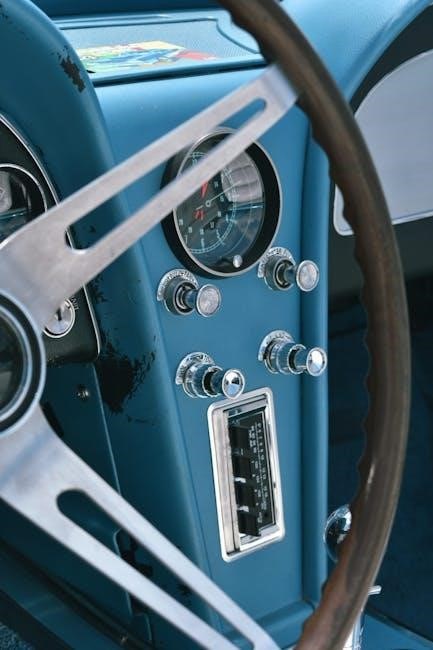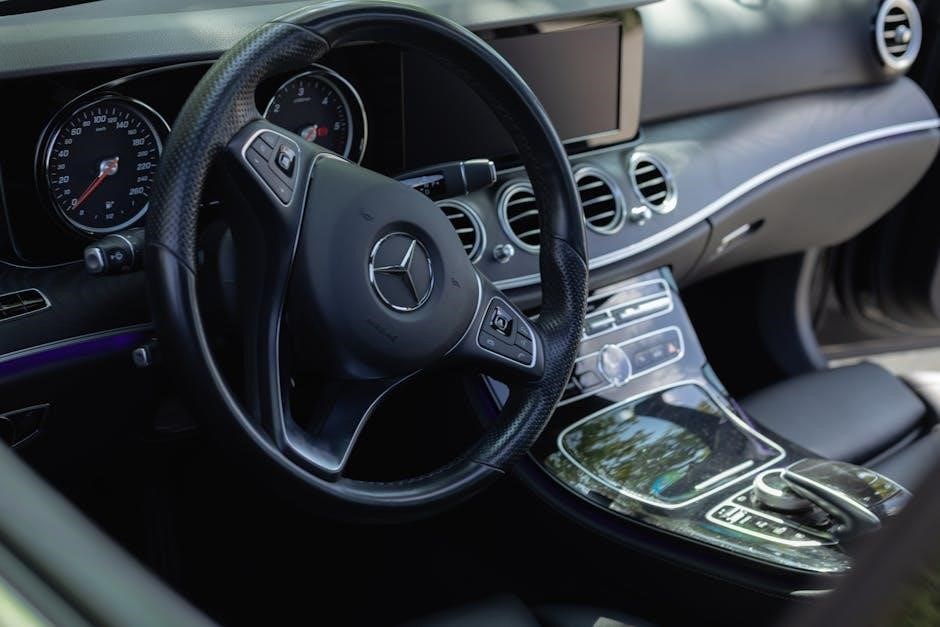Power steering and manual steering are two distinct systems that assist drivers in controlling vehicle direction․ Power steering uses mechanical or electrical assistance to simplify steering, while manual steering relies solely on the driver’s physical effort․ Both systems have unique advantages and disadvantages, influencing driver preference based on vehicle type, driving conditions, and personal needs․

1․1 Overview of Power Steering
Power steering is a system designed to reduce the physical effort required to steer a vehicle by providing mechanical or electrical assistance․ It enhances maneuverability, especially at low speeds, making parking and tight turns easier․ Modern power steering systems are typically hydraulic or electric, with electric power steering (EPS) being more common in newer vehicles due to its efficiency and reduced maintenance․ The system uses sensors to detect steering wheel movement and applies assistance via an electric motor or hydraulic pump․ This technology improves driving comfort and reduces driver fatigue, particularly in urban driving conditions․ Power steering fluid is essential for hydraulic systems, ensuring smooth operation and preventing corrosion․ Overall, power steering has become a standard feature in most vehicles, offering significant advantages over manual steering in terms of ease and convenience․
1․2 Overview of Manual Steering
Manual steering systems rely entirely on the driver’s physical input to control the vehicle’s direction․ Unlike power steering, manual systems do not use any mechanical or electrical assistance, making them simpler in design and requiring less maintenance․ The steering mechanism directly connects to the wheels via a series of gears and linkages, providing a more direct feel and better feedback to the driver․ Manual steering is typically found in older vehicles or specialized cars where the driver prefers a more engaged driving experience․ While it demands more effort, especially at low speeds or when parking, manual steering systems are durable, cost-effective, and free from the complexities associated with power steering systems․ This simplicity makes them a preferred choice for some enthusiasts who value precision and control․

How Power Steering Works
Power steering uses hydraulic or electric systems to assist steering, reducing effort needed to turn the wheels․ The system includes a pump, fluid, and gears to aid movement․
2․1 Components of Power Steering System
The power steering system consists of several key components that work together to provide assisted steering․ The heart of the system is the steering gear, which converts the rotational motion of the steering wheel into linear motion to turn the wheels․ The power steering pump generates hydraulic pressure, which is transmitted through high-pressure hoses to the steering rack or gear box․ Additionally, the system includes fluid reservoirs to hold the hydraulic fluid, return lines to circulate the fluid back to the pump, and control valves to regulate fluid flow based on steering input․ In electric systems, an electric motor replaces the hydraulic pump, providing steering assistance directly․ These components ensure smooth and effortless steering, enhancing overall driving comfort and control․
2․2 Hydraulic vs Electric Power Steering
Hydraulic and electric power steering systems differ significantly in operation and performance․ Hydraulic systems rely on a mechanical pump to circulate pressurized fluid, which assists steering by applying force to the steering gear․ This setup is robust and reliable but can be less fuel-efficient due to constant pump operation․ In contrast, electric power steering (EPS) uses an electric motor to provide assistance, activated only when needed, improving efficiency; EPS systems are lighter, quieter, and more adaptable, often integrating advanced driver-assistance features․ Hydraulic systems, while effective, are heavier and less environmentally friendly․ The choice between the two often depends on vehicle size, driving conditions, and the need for modern technological advancements in steering technology․
2․3 Advantages of Power Steering
Power steering offers numerous benefits that enhance the driving experience․ It significantly reduces the physical effort required to steer, making maneuvering easier, especially in low-speed situations like parking or navigating tight spaces․ This reduction in driver fatigue is particularly advantageous on long drives or in urban environments with frequent turns․ Additionally, power steering improves vehicle stability and control, allowing for smoother lane changes and better handling at higher speeds․ Modern systems also provide adjustable settings, catering to different driving preferences․ The integration of advanced features like lane-keeping assist further enhances safety and convenience, making power steering a preferred choice for many drivers seeking comfort and precision behind the wheel․
2․4 Disadvantages of Power Steering
Despite its benefits, power steering has some drawbacks․ One major disadvantage is its reliance on power steering fluid, which can leak or degrade over time, leading to system failures․ Additionally, power steering systems are more complex and expensive to repair compared to manual steering․ The added weight and cost of components like pumps and motors can also increase vehicle expenses․ Furthermore, some drivers find that power steering reduces road feel, making it less engaging for enthusiasts․ In cases of system failure, steering becomes extremely difficult, especially at high speeds․ Finally, the energy required to power these systems can slightly reduce fuel efficiency, making them less ideal for eco-conscious drivers․ These factors highlight the trade-offs of choosing power steering over manual systems․

How Manual Steering Works
Manual steering relies on mechanical connections between the steering wheel, shaft, gearbox, and steering linkages, requiring physical effort from the driver to turn the wheels․
3․1 Components of Manual Steering System
A manual steering system consists of several key components that work together to enable vehicle direction control․ The primary components include the steering wheel, which the driver turns, and the steering shaft, connecting the wheel to the gearbox․ The steering gearbox (or steering gear) converts the rotational motion of the shaft into mechanical energy to turn the wheels․ This is typically a rack-and-pinion or recirculating ball system․ Additionally, steering linkages, such as tie rods and idler arms, ensure synchronized movement of the front wheels․ Other components include the pitman arm and drag link, which connect the gearbox to the front axle or steering knuckles․ These parts ensure precise control without hydraulic or electric assistance, relying solely on mechanical connections and driver input․
3․2 Advantages of Manual Steering
Manual steering offers several distinct advantages that make it appealing in specific scenarios․ One of the most significant benefits is its simplicity and reliability, as it lacks complex hydraulic or electrical components, reducing the risk of system failure․ This simplicity also results in lower maintenance costs, as there are fewer parts that can wear out or malfunction․ Additionally, manual steering provides direct driver feedback, allowing for a more connected and precise driving experience, especially on smooth roads․ It is also lighter in weight compared to power steering systems, which can improve fuel efficiency in some cases․ Furthermore, manual steering systems are often more durable and require less energy to maintain over time, making them a preferred choice for certain drivers and vehicle types․
3․3 Disadvantages of Manual Steering
Manual steering has several drawbacks that can make it less convenient for many drivers․ One major disadvantage is the increased physical effort required, especially during low-speed maneuvers like parking or navigating tight spaces․ This can lead to driver fatigue on long trips or in heavy traffic․ Additionally, manual steering systems lack the assistance provided by power steering, making it more challenging to control larger or heavier vehicles․ The absence of power assistance also means less stability and control during sudden maneuvers or emergency situations․ Furthermore, manual steering systems can be more difficult to handle for drivers with limited strength or mobility, making them less accessible for some individuals․ Overall, while manual steering offers simplicity, it compromises on comfort and ease of use in many driving scenarios․
Power Steering vs Manual Steering: Direct Comparison
Power steering offers greater ease of use and reduced effort, especially in larger vehicles, while manual steering provides a simpler, cost-effective option with more direct road feedback․
4․1 Ease of Use
Power steering significantly reduces the physical effort required to steer a vehicle, making it easier to maneuver, especially at low speeds or in tight spaces․ This is particularly beneficial for larger or heavier vehicles, where manual steering would be notably more demanding․ In contrast, manual steering requires the driver to exert more force, which can be tiring during prolonged drives or in urban environments with frequent turns․ However, manual steering often provides a more direct connection to the road, allowing drivers to feel the vehicle’s responses more intuitively․ The choice between the two systems ultimately depends on the driver’s preference for convenience versus tactile feedback․

4․2 Maintenance Requirements
Power steering systems generally require more maintenance than manual steering systems․ They involve components like power steering fluid, pumps, and motors, which need regular checks and potential replacements․ Fluid levels must be monitored, and leaks addressed promptly to prevent system failure․ In contrast, manual steering systems are simpler, with fewer moving parts, resulting in lower maintenance needs․ However, they still require occasional lubrication of steering components and inspection for wear․ Overall, power steering systems, while convenient, demand more attention and can incur higher maintenance costs over time, whereas manual systems are more straightforward and cost-effective in terms of upkeep․
4․3 Cost Differences
Power steering systems are typically more expensive to install and maintain compared to manual steering systems․ The components, such as power steering pumps, motors, and fluid, add to the initial and long-term costs․ In contrast, manual steering systems are simpler, with fewer parts, making them more cost-effective upfront․ However, the higher cost of power steering is often offset by its convenience and ease of use, especially in larger or heavier vehicles․ Manual steering, while cheaper, may require more physical effort, which can be a trade-off for drivers prioritizing affordability․ Overall, power steering systems generally have higher associated costs, but they offer significant benefits in terms of driving comfort and accessibility․
4․4 Fuel Efficiency
Fuel efficiency varies between power steering and manual steering systems․ Power steering systems, especially hydraulic ones, can consume engine power, potentially reducing fuel efficiency․ This is because the power steering pump is driven by the engine, adding a constant load․ Electric power steering (EPS), however, is more efficient as it only uses energy when steering assistance is needed․ Manual steering systems, without any power assistance, generally have better fuel efficiency since they do not draw engine power․ The choice between the two may depend on whether the priority is fuel economy or the convenience of power-assisted steering․ Modern advancements in EPS have narrowed the efficiency gap, making power steering a more viable option for eco-conscious drivers while still offering improved handling․
4․5 Reliability and Durability
Power steering systems, particularly hydraulic ones, can be less reliable due to their complexity and reliance on fluid pressure․ Components like pumps, hoses, and seals are prone to wear and tear, leading to potential failures over time․ Electric power steering (EPS) is generally more reliable as it has fewer mechanical parts, reducing the risk of breakdowns․ Manual steering systems, while simpler, are known for their durability since they lack power-assisted components, minimizing the chance of mechanical failure․ However, manual systems can be more physically demanding, potentially leading to wear on linkages and joints․ Overall, manual steering is often considered more durable, while EPS offers a reliable compromise between convenience and longevity․ Regular maintenance is key for both systems to ensure optimal performance and extend their lifespan․

Driving Experience: Power Steering vs Manual Steering
Power steering offers a smoother, less physically demanding driving experience, making maneuverability easier at low speeds․ Manual steering provides direct feedback, enhancing precision and driver engagement, especially at higher speeds․
5․1 Steering Feedback and Precision
Steering feedback and precision differ significantly between power steering and manual steering systems․ Power steering reduces physical effort but may diminish direct road feedback, making it less precise at high speeds․ Manual steering offers more tactile feedback, allowing drivers to feel the road better, which enhances precision and control, especially during aggressive maneuvers․ However, manual steering requires more strength and effort, particularly at low speeds․ The choice between the two often depends on the driver’s preference for comfort versus responsiveness․ Modern advancements, like electric power steering, aim to balance ease of use with improved feedback, while manual systems remain popular among enthusiasts who value a more connected driving experience․
5․2 Maneuverability in Different Conditions
Maneuverability varies significantly between power steering and manual steering systems across different driving conditions․ Power steering excels in tight spaces and low-speed maneuvers, such as parking, due to its reduced effort requirements․ It also performs well in heavy vehicles or large trucks, where manual steering would be impractical․ However, in rough or uneven terrain, manual steering often provides better control and stability, as it allows drivers to feel the resistance and adjust more precisely․ Additionally, manual steering can offer superior responsiveness during high-speed cornering or emergency maneuvers, where precise control is critical․ Power steering, while easier in most scenarios, may lack the direct connection to the road that manual systems provide, making it less favorable for enthusiasts seeking maximum handling precision․
5․3 Parking and Low-Speed Handling
Parking and low-speed handling are areas where power steering significantly outperforms manual steering․ Power steering reduces the effort needed to turn the wheels, making tight maneuvers and parking in confined spaces much easier․ This is particularly beneficial for drivers who frequently navigate urban environments or compact parking lots․ In contrast, manual steering requires more physical effort and can be cumbersome at low speeds, especially in larger vehicles․ However, some drivers prefer manual steering for its direct feedback, which can enhance control during precise maneuvers․ Overall, power steering offers greater convenience and ease in low-speed situations, while manual steering appeals to those who value a more connected driving experience․ The choice ultimately depends on the driver’s priorities and driving habits․

Modern Advancements in Steering Technology
Modern advancements in steering technology include electric power steering systems, adaptive steering, and hybrid solutions․ These innovations enhance precision, reduce effort, and improve overall driving efficiency and safety․
6․1 Electric Power Steering (EPS)
Electric Power Steering (EPS) replaces traditional hydraulic systems with electric motors and sensors, enhancing efficiency and precision․ EPS systems automatically adjust steering effort based on speed and driving conditions, providing smoother handling․ Unlike hydraulic systems, EPS only consumes power when assistance is needed, improving fuel efficiency․ Modern EPS systems integrate advanced features like variable assist, self-centering, and torque feedback, offering a more responsive and adaptable driving experience․ This technology has become standard in most vehicles due to its reliability, reduced maintenance, and compatibility with advanced driver-assistance systems (ADAS)․ EPS also enables features like lane-keeping assist and automatic parking, making it a cornerstone of modern steering innovation․
6․2 Adaptive Steering Systems
Adaptive steering systems dynamically adjust the steering ratio based on vehicle speed and driving conditions, optimizing maneuverability and stability․ These systems use advanced sensors and electronic controls to vary how much the wheels turn relative to the driver’s input․ At lower speeds, the system reduces the number of turns needed for parking and tight maneuvers, while at higher speeds, it increases precision and directional control․ This adaptability enhances overall driving comfort and safety․ Adaptive steering often integrates with other technologies, such as lane-keeping assist, to provide a more intuitive and responsive driving experience․ By continuously adjusting to real-time conditions, adaptive steering systems deliver a seamless connection between the driver and the road, improving both efficiency and enjoyment behind the wheel․
6․3 Hybrid Steering Systems
Hybrid steering systems combine elements of electric and hydraulic power steering to deliver enhanced performance and efficiency․ These systems use electric motors for everyday driving, switching to hydraulic assistance during high-demand situations, such as heavy loading or extreme temperatures․ This dual approach ensures consistent steering feel while optimizing fuel efficiency and reducing emissions․ Advanced sensors and software adapt the system to driving conditions, balancing comfort and precision․ Hybrid systems are particularly beneficial in vehicles that require both urban maneuverability and highway stability․ By integrating the strengths of both technologies, hybrid steering systems offer a versatile solution for modern vehicles, catering to diverse driving needs while maintaining reliability and reducing mechanical complexity compared to traditional setups․

Maintenance and Troubleshooting
Regular fluid checks and belt inspections are crucial for power steering systems, while manual systems require lubrication and wear checks to ensure smooth, reliable operation over time․
7․1 Power Steering Fluid: Importance and Replacement
Power steering fluid is essential for lubricating the system, preventing corrosion, and maintaining optimal performance․ Regular checks are crucial to ensure proper fluid levels, as low levels can lead to system damage․ Replacement intervals vary by vehicle, typically every 30,000 to 60,000 miles, depending on usage and manufacturer recommendations․ Using the correct fluid type, as specified in the vehicle’s handbook, is vital to avoid system contamination․ Over time, the fluid can degrade, losing its lubricating properties and potentially causing component wear․ Neglecting fluid maintenance can result in expensive repairs, such as replacing the power steering pump or rack-and-pinion system․ Always consult the vehicle’s manual for specific guidance on fluid replacement and maintenance schedules to ensure long-term system reliability and performance․
7․2 Belt Replacements in Power Steering
The power steering belt plays a crucial role in transferring power from the engine to the power steering pump․ Over time, the belt can wear out, crack, or fray, leading to system failure․ Regular inspections are necessary to identify signs of wear, such as cracks, glazing, or misalignment․ Replacing the belt at the recommended interval, typically every 50,000 to 90,000 miles, ensures smooth operation and prevents sudden loss of steering assistance․ Failure to replace a worn belt can result in costly damage to the pump and other components․ It’s important to use a high-quality belt that meets manufacturer specifications and to ensure proper tensioning during installation․ Proper belt maintenance is essential for maintaining safe and reliable steering performance․
7․3 Common Issues in Manual Steering Systems
Manual steering systems, while durable, can develop issues due to wear and tear․ A common problem is steering gear wear, which can make steering feel loose or difficult to control․ The steering box and linkage may also degrade, causing play in the steering wheel or uneven tire wear․ Additionally, worn wheel bearings can lead to vibrations and instability, especially at higher speeds․ Steering column misalignment or excessive play can result in poor handling and driver fatigue․ Over time, bushings and seals may deteriorate, leading to leaks or further mechanical damage․ Regular inspections and timely replacements of worn components are essential to maintain safety and performance․ Proper maintenance can extend the lifespan of manual steering systems and ensure reliable operation․


The Future of Steering Technology
Future steering systems are expected to integrate advanced autonomous and adaptive features, enhancing safety and efficiency․ Electric power steering will remain central, with innovations like steer-by-wire and automated driving capabilities emerging as standard․
8․1 Autonomous Steering Systems
Autonomous steering systems represent the next evolution in vehicle control, combining advanced sensors, AI, and electric power steering to enable self-driving capabilities․ These systems eliminate the need for manual input, relying instead on real-time data to navigate roads safely․ Unlike traditional power steering, autonomous systems adapt to driving conditions automatically, enhancing precision and reducing driver fatigue․ They integrate seamlessly with existing power steering mechanisms, offering a smoother transition to autonomous driving․ While manual steering requires constant driver engagement, autonomous systems operate independently, making them ideal for future vehicles․ As technology advances, autonomous steering is poised to revolutionize the automotive industry, prioritizing safety, efficiency, and convenience․
8․2 The Role of EPS in Modern Vehicles
Electric Power Steering (EPS) has become integral to modern vehicles, offering enhanced control and efficiency․ Unlike traditional hydraulic systems, EPS uses electric motors to assist steering, reducing mechanical complexity and improving fuel economy․ Its adaptability allows for customizable steering feel, catering to diverse driving scenarios․ EPS also enables advanced features like lane-keeping assist and automatic parking, making it a cornerstone of contemporary automotive technology․ By eliminating the need for power steering fluid and belts, EPS reduces maintenance needs․ Its compact design and energy efficiency align with the industry’s shift toward greener, smarter vehicles․ As a result, EPS is now a standard feature in most new cars, blending performance with innovation․
8․3 Upcoming Innovations in Steering Technology
Future steering technologies promise significant advancements, blending autonomy and driver assistance․ Steer-by-wire systems, eliminating mechanical links, are expected to enhance safety and control․ Predictive steering systems, leveraging AI, will anticipate road conditions and adjust assistance proactively․ Integration with autonomous driving features, like automatic lane centering and traffic jam assist, is on the horizon․ Additionally, regenerative steering systems aim to harvest energy, improving efficiency․ These innovations aim to create safer, more intuitive, and efficient driving experiences, catering to both autonomous and manual driving modes․ As vehicles evolve, steering technology will play a pivotal role in shaping the future of mobility, offering unparalleled precision and convenience․
9․1 Final Thoughts on Power Steering vs Manual Steering
The debate between power steering and manual steering ultimately hinges on personal preference and driving context․ Power steering excels in urban settings, offering effortless maneuverability and reduced driver fatigue․ However, manual steering provides a more authentic connection to the road, often preferred by enthusiasts for its precision and feedback․ Modern advancements, such as electric power steering (EPS), have bridged the gap, combining ease of use with enhanced control․ For everyday commuters, power steering is ideal, while manual steering appeals to those seeking a more immersive driving experience․ Balancing convenience, performance, and cost, each system has its place in the automotive world․

